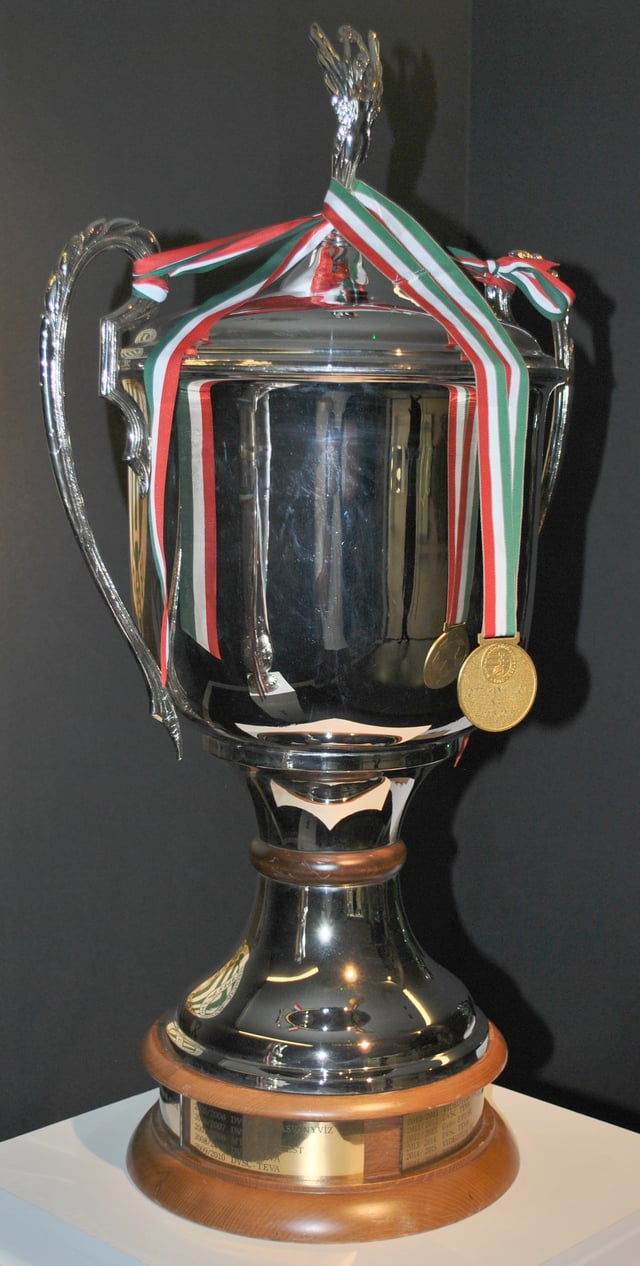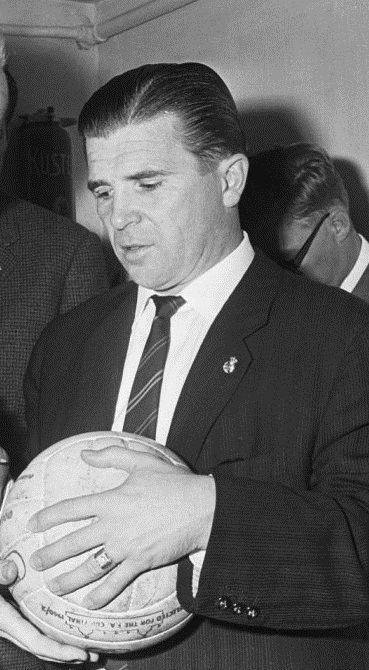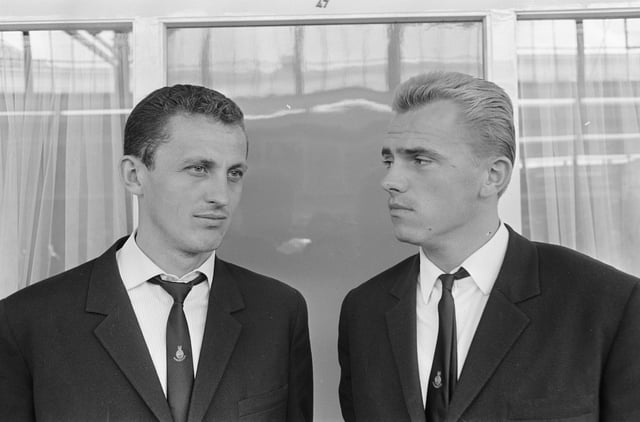Nemzeti Bajnokság I

Nemzeti Bajnokság I

| Founded | 1901 |
|---|---|
| Country | Hungary |
| Confederation | UEFA |
| Number of teams | 12 |
| Level on pyramid | 1 |
| Relegation to | Nemzeti Bajnokság II |
| Domestic cup(s) | Magyar Kupa |
| International cup(s) | UEFA Champions League UEFA Europa League |
| Current champions | Ferencváros (30th title) (2018–19) |
| Most championships | Ferencváros (30 titles) |
| TV partners | M4 Duna TV Duna World |
| Website | Magyar Labdarúgó Szövetség [58] |
The Nemzeti Bajnokság (Hungarian pronunciation: [ˈnɛmzɛti ˈbɒjnokʃaːɡ], "National Championship") is the Hungarian professional league for association football clubs. The league is currently known as the OTP Bank Liga for sponsorship reasons,[1] and it has been the highest level of the professional league since its inception in 1901. UEFA currently ranks the league 36th in Europe.[2]
Twelve teams compete in the league, playing each other thrice, once at home and once away. At the end of the season, the top team enters the qualification for the UEFA Champions League, while the runner-up and the third place, together with the winner of the Hungarian Cup enter the UEFA Europa League qualification round. The bottom two clubs are relegated to Nemzeti Bajnokság II, the second-level league, to be replaced by the winner and the runner up of the NB2.
| Founded | 1901 |
|---|---|
| Country | Hungary |
| Confederation | UEFA |
| Number of teams | 12 |
| Level on pyramid | 1 |
| Relegation to | Nemzeti Bajnokság II |
| Domestic cup(s) | Magyar Kupa |
| International cup(s) | UEFA Champions League UEFA Europa League |
| Current champions | Ferencváros (30th title) (2018–19) |
| Most championships | Ferencváros (30 titles) |
| TV partners | M4 Duna TV Duna World |
| Website | Magyar Labdarúgó Szövetség [58] |
History

The trophy of the Nemzeti Bajnokság

Ferenc Puskás scored 352 goals in 341 matches for Budapest Honvéd

Ferencváros legend Albert with Vasas legend Mészöly in the 1960s
In the 1930s, the rivalry between Ferencváros and MTK Budapest expanded with another club, Újpest FC (at that time not part of Budapest).[7] One of the most iconic figures of the 1930s Hungarian football was Újpest's Zsengellér who managed to top goalscorer three times in a row in the 1930s.[8] Ferencváros's Sárosi[9] and MTK Budapest's Cseh[10] and Újpest's Zsengellér were the embodiment of the rivalry of the three clubs from Budapest, named Budapest derby.[11]
In the 1940s, Csepel could win its first title which was followed by two other titles in 1942 and 1943.[12] During the World War II there were no interruptions in the Hungarian league. Due to the expansion of the territories of the country, new clubs could re-join the league such as Nagyvárad[13] and Kolozsvár.[14] The second half of the 1940s was dominated by Újpest by winning the championship in 1945, 1946 and 1947.[15]
In the 1950s, the dominance of Ferencváros and MTK weakened by the emergence of Honvéd with players such as Puskás,[16] Bozsik,[17] Czibor[18] and Budai.[19] Later these players played in the final of the 1954 FIFA World Cup. In the 1950s, Honvéd could win the championship five times. During the early 1950s, Honvéd players formed the backbone of the legendary Mighty Magyars. In 1956 the Hungarian league was suspended due to the Hungarian Revolution. The league was led by Honvéd after 21 rounds but the championship has never been finished.[20] In the first season (1955-56) of the European Cup, MTK Budapest reached the quarter-finals while in the 1957-58 season Vasas Budapest played in the semi-finals of the European Cup.
Vasas won four titles in the 1960s (1960/61, 1961/62, 1965 and 1966).[21]
Ujpest dominated the 1970s, winning seven titles.[22]
In 1982 Győr won the championship becoming the first non-Budapest team who could win the Hungarian league (except Nagyvárad during the World War II). Győr could repeat the triumph in the following year in 1983. However, the 1980s was dominated by Honvéd who celebrated its second heyday during the 1980s.[23]
Due to the collapse of communism, Hungarian football clubs lost the support of the state. Therefore, many clubs were faced with financial problems the effects of which are still present in Hungarian football. However, the 1990s were still dominated by the 'traditional' clubs of the championships such as Ferencváros, MTK and Újpest. Frencváros always finished in the top three, except for the 1993–94 season, when they finished 4th. The financial problems affected the performance of the clubs outside the Hungarian League as well. Hungarian clubs could not compete with their European counterparts. Moreover, the Bosman ruling also had a deep impact on the Hungarian League. Since big European clubs could invest loads of money into football, clubs from the Eastern Bloc were restricted to employing only home nationals.[24]
Format
As of the 2016–17 season there are 12 clubs in the division, who play each other thrice for a total of 33 games each. The bottom two clubs are relegated.[39]
| Season | Number of teams | |||||
|---|---|---|---|---|---|---|
| from 1901 to 1902 | 5 teams | |||||
| in 1903 | 8 teams | |||||
| from 1904 to 1905 | 9 teams | |||||
| in 1906-07 | 8 teams | |||||
| from 1907-08 to 1909-10 | 9 teams | |||||
| from 1910-11 to 1913-14 | 10 teams | |||||
| from 1916-17 to 1918-19 | 12 teams | |||||
| in 1919-20 | 15 teams | |||||
| in 1920-21 | 13 teams | |||||
| from 1921-22 to 1925-26 | 12 teams | |||||
| in 1926-27 | 10 teams | |||||
| from 1927-28 to 1934-35 | 12 teams | |||||
| from 1935-36 to 1940-41 | 14 teams | |||||
| from 1941-42 to 1943-44 | 16 teams | |||||
| in 1945 | 28 teams | |||||
| in 1946-47 | 16 teams | |||||
| in 1947-48 | 17 teams | |||||
| from 1948-49 to 1950 | 16 teams | |||||
| from 1951 to 1955 | 14 teams | |||||
| in 1957 | 12 teams | |||||
| from 1957-58 to 1966 | 14 teams | |||||
| from 1967 to 1973-74 | 16 teams | |||||
| in 1974-75 | 15 teams | |||||
| in 1975-76 | 16 teams | |||||
| from 1976-77 to 1981-82 | 18 teams | |||||
| from 1982-83 to 1995-96 | 16 teams | |||||
| from 1996-97 to 1999-00 | 18 teams | |||||
| in 2000-01 | 16 teams | |||||
| from 2001-02 to 2003-04 | 12 teams | |||||
| from 2004-05 to 2014-15 | 16 teams | |||||
| from 2015–16 to present | 12 teams[40] | |||||
|
|
| ||||
| Club | Titles | Winning seasons | ||||
| Ferencváros | 30 | 1903, 1905, 1906–07, 1908–09, 1909–10, 1910–11, 1911–12, 1912–13, 1925–26, 1926–27, 1927–28, 1931–32, 1933–34, 1937–38, 1939–40, 1940–41, 1948–49, 1962–63, 1964, 1967, 1968, 1975–76, 1980–81, 1991–92, 1994–95, 1995–96, 2000–01, 2003–04, 2015–16, 2018–19 | ||||
| MTK Budapest | 23 | 1904, 1907–08, 1903–14, 1916–17, 1917–18, 1918–19, 1919–20, 1920–21, 1921–22, 1922–23, 1923–24, 1924–25, 1928–29, 1935–36, 1936–37, 1951, 1953, 1957–58, 1986–87, 1996–97, 1998–99, 2002–03, 2007–08 | ||||
| Újpest | 20 | 1929–30, 1930–31, 1932–33, 1934–35, 1938–39, 1945, 1945–46, 1946–47, 1959–60, 1969, 1970, 1970–71, 1971–72, 1972–73, 1973–74, 1974–75, 1977–78, 1978–79, 1989–90, 1997–98 | ||||
| Budapest Honvéd | 14 | 1949–50 (I), 1950 (II), 1952, 1954, 1955, 1979–80, 1983–84, 1984–85, 1985–86, 1987–88, 1988–89, 1990–91, 1992–93, 2016–17 | ||||
| Debrecen | 7 | 2004–05, 2005–06, 2006–07, 2008–09, 2009–10, 2011–12, 2013–14 | ||||
| Vasas | 6 | 1957, 1960–61, 1961–62, 1965, 1966, 1976–77 | ||||
| Győr * | 4 | 1963, 1981–82, 1982–83, 2012–13 | ||||
| Csepel | 4 | 1941–42, 1942–43, 1947–48, 1958–59 | ||||
| Fehérvár | 3 | 2010–11, 2014–15, 2017–18 | ||||
| Budapesti TC | 2 | 1901, 1902 | ||||
| Vác | 1 | 1993–94 | ||||
| Nagyvárad ‡ | 1 | 1943–44 | ||||
| Dunaferr | 1 | 1999–2000 | ||||
| Zalaegerszeg | 1 | 2001–02 | ||||
| Season | Number of teams | |||||
| 115 | Ferencváros | |||||
| 112 | Újpest | |||||
| 108 | MTK Budapest | |||||
| 105 | Budapest Honvéd | |||||
| 86 | Vasas | |||||
| 69 | Győr | |||||
| 63 | Szombathely | |||||
| 52 | Diósgyőr, Csepel | |||||
| 50 | Pécs | |||||
| 50 | Fehérvár | |||||
| Name | Period | Clubs | Goals | Matches | Average | |
| Ferenc Szusza | 1940–1961 | Újpest | 393 | 462 | 0,85 | |
| Gyula Zsengellér | 1935–1947 | Salgótarjáni BTC, Újpest | 387 | 325 | 1,22 | |
| József Takács | 1920–1940 | Vasas Budapest, Ferencváros, Erszébet, Szürketaxi | 360 | 355 | 1,01 | |
| Ferenc Puskás | 1943–1956 | Kispest-Honvéd | 357 | 354 | 1,01 | |
| György Sárosi | 1931–1948 | Ferencváros | 351 | 383 | 0,92 | |
| Gyula Szilágyi | 1943–1960 | Debrecen, Vasas | 313 | 390 | 0,80 | |
| Ferenc Deák | 1944–1954 | Szentlőrinc, Ferencváros, Újpest | 305 | 238 | 1,28 | |
| Ferenc Bene | 1960–1978 | Újpest | 303 | 418 | 0,72 | |
| Géza Toldi | 1928–1946 | Ferencváros, Gamma-Budatok, Szegedi AK, MADISZ | 271 | 324 | 0,84 | |
| 11 | Nandor Hidegkuti | 1942–1958 | MTK-Hungaria | 265 | 381 | 0,70 |
| Flórián Albert | 1959–1974 | Ferencváros | 256 | 351 | 0,73 | |
| Once | Once | Twice3 times | 4 times5 times7 times | |||
|
| |||||
| Year | Average | Change | ||||
| 1957 | 17,083 | / | ||||
| 1957/58 | 14,668 | -14,1% | ||||
| 1958/59 | 14,659 | -0,1% | ||||
| 1959/60 | 16,712 | +14,0% | ||||
| 1960/61 | 15,198 | -9,1% | ||||
| 1961/62 | 12,951 | -14,8% | ||||
| 1962/63 | 14,184 | +9,5% | ||||
| 1963 | 13,649 | -3,8% | ||||
| 1964 | 16,151 | +18,1% | ||||
| 1965 | 14,521 | -10,1% | ||||
| 1966 | 11,951 | -17,7% | ||||
| 1967 | 11,368 | -4,9% | ||||
| 1968 | 9,392 | -17,4% | ||||
| 1969 | 8,343 | -11,2% | ||||
| 1970 | 8,668 | +3,9% | ||||
| Year | Average | Change | ||||
| 1970/71 | 7,067 | -18,5% | ||||
| 1971/72 | 6,135 | -13,2% | ||||
| 1972/73 | 7,208 | +17,5% | ||||
| 1973/74 | 8,163 | +13,2% | ||||
| 1974/75 | 8,717 | +6,8% | ||||
| 1975/76 | 10,108 | +16,0% | ||||
| 1976/77 | 8,834 | -12,6% | ||||
| 1977/78 | 8,026 | -9,1% | ||||
| 1978/79 | 6,606 | -17,7% | ||||
| 1979/80 | 7,588 | +14,9% | ||||
| 1980/81 | 6,835 | -9,9% | ||||
| 1981/82 | 7,039 | +3,0% | ||||
| 1982/83 | 9,576 | +36,0% | ||||
| 1983/84 | 7,896 | -17,5% | ||||
| 1984/85 | 7,812 | -1,1% | ||||
| Year | Average | Change | ||||
| 1985/86 | 7,581 | -3,0% | ||||
| 1986/87 | 7,683 | +1,3% | ||||
| 1987/88 | 7,977 | +3,8% | ||||
| 1988/89 | 6,925 | -13,2% | ||||
| 1989/90 | 5,888 | -15,0% | ||||
| 1990/91 | 5,307 | -9,9% | ||||
| 1991/92 | 5,586 | +5,2% | ||||
| 1992/93 | 5,398 | -3,4% | ||||
| 1993/94 | 5,355 | -0,8% | ||||
| 1994/95 | 5,842 | +9,1% | ||||
| 1995/96 | 4,965 | -15,0% | ||||
| 1996/97 | 4,443 | -10,5% | ||||
| 1997/98 | 5,786 | +30,2% | ||||
| 1998/99 | 5,009 | -13,4% | ||||
| 1999/00 | 3,686 | -26,4% | ||||
| Year | Average | Change | ||||
| 2000/01 | 4,420 | +12,0% | ||||
| 2001/02 | 3,961 | -10,4% | ||||
| 2002/03 | 3,396 | -14,3% | ||||
| 2003/04 | 3,406 | +0,3% | ||||
| 2004/05 | 3,291 | -3,4% | ||||
| 2005/06 | 3,136 | -4,7% | ||||
| 2006/07 | 2,755 | -12,1% | ||||
| 2007/08 | 2,975 | +8,0% | ||||
| 2008/09 | 2,953 | -0,7% | ||||
| 2009/10 | 3,115 | +5,5% | ||||
| 2010/11 | 2,812 | -9,7% | ||||
| 2011/12 | 3,858 | +37,2% | ||||
| 2012/13 | 2,844 | -26,3% | ||||
| 2013/14 | 2,993 | +5,2% | ||||
| 2014/15 | 2,505 | -16,3% | ||||
| Year | Average | Change | ||||
| 2015/16 | 2,602 | +3,9% | ||||
| 2016/17 | 2,705 | +4,0% | ||||
| 2017/18 | 2,907 | +7,5% | ||||
| 2018/19 | 3,300 | +16,0% |